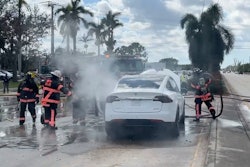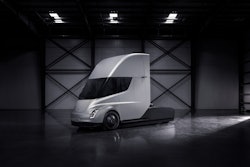The chicken and egg analogy to describe grid preparedness versus zero-emission truck availability has grown irrelevant. It is an overly simplistic characterization of a very complex interaction of forces.
Customers create demand by ordering commercial zero-emission vehicles (ZEVs). The security provided by those orders creates real demand for infrastructure to support deploying those ZEVs. Utilities use real demand to convince public utility commissions to invest capital in new generation and distribution capacity.
Where infrastructure demand exceeds capacity there is greater urgency to invest in infrastructure. Utilities are not set up to have significant idle, unused assets, neither grid transmission nor power generation. Commercial and public users may complain when peak conditions force brownouts or blackouts but, quite frankly, we are our own worst enemy as we do not incentivize utilities to have spare capacity. We focus on the low cost of electricity.
Demand pulls infrastructure investment. Very rarely do we approve of having excess capacity sitting idle waiting for emergencies. We prefer to complain and blame during and after an emergency that the infrastructure was not better prepared. It’s like having a rainy-day fund that we never adequately fund for that inevitable rainy day.
Call it a demand-response paradigm. Response almost always lags demand. I believe this explains why powerhouse states like California and Texas have operated on the dangerous fringe of electric utility capacity in recent years. Infrastructure investment has lagged demand growth in spite of multiple quality demand growth projections.
Today we are standing on the beach obviously watching the tide rushing out – surprised fish flopping in the sand, a clear sign of a coming tsunami and, as a society, and as an industry, we are waiting for that tsunami before investing in infrastructure. We seem to rationalize spending for catastrophe recovery, but not the less expensive proactive resiliency investment.
Commercial ZEVs are coming. This year OEMs are starting to ramp up production from ones and twos to 50 to 100 vehicles a quarter. Soon it will be thousands. In the 2035 to 2045 timeframe, the majority of diesel truck production will be replaced by ZEVs.
I wanted to do a back of the envelope estimate of annual ZEV transport electricity demand from this growing pool of ZEVs.
A good market year for diesel production sees 300,000 Class 7 and 8 units and perhaps 400,000 Class 2b through Class 6 medium-duty trucks.
And, yes, hydrogen fuel cell ZEVs need large amounts of electricity too, an inconvenient point left out of many discussions. Just compressing hydrogen to get it into the truck requires two, three or more kWh of electricity per kg according to multiple reliable sources. This is before accounting for electricity for aspects of carbon sequestration schemes or electrolyzed needs for creating the hydrogen from water.
For the purposes of my back of the envelope calculation, let’s say the average battery electric Class 7 or 8 truck has a 400 kWh battery. Also assume the average medium-duty BEV has an 80-kWh pack. The average fuel cell electric vehicle has a 60 kg hydrogen tank filled once a day to 750 Bar pressure for a heavy-duty truck.
In 2040, let’s assume half of new Class 8 trucks sold that year are battery electric, half sold are fuel cell, and all new medium-duty sold that year are battery electric.
This means for Class 7 and 8 BEVs at least 150,000 vehicles x 400 kWh per day are needed. At five days a week and 50 weeks of operation, that is 15 terawatt-hours of annual demand.
For medium-duty BEVs, 400,000 vehicles x 80kWh, five days a week for 50 work weeks a year, means 8 terawatt-hours of demand a year.
For the fuel cells, accounting just for compressing hydrogen gas to 750 Bar pressures at an optimistic 2kWh/kg, that is 150,000*60 kg x 2 kWh/kg, at five days a week for 50 work weeks per year gives 4.5 terawatt-hours annual demand.
These three estimates total 27.5 terawatt-hours of new commercial vehicle demand added each year from new truck sales. A recent U.S. Energy Information Administration (EIA) annual estimate of total electricity generation in the U.S. for 2021 is 4.12 terawatt-hours.
This is just one rough estimate based on typical truck market production numbers for just one year of production. It illustrates the scale of the challenge facing the electric utility industry to support zero-emission vehicle deployments. The current grid must grow in multiples to support the future with ZEVs.
Hudson Gilmer, chief operating officer of LineVision Inc., quoted a Princeton study in his panel session at Transmission and Delivery World 2022 in Charlotte, North Carolina. Gilmer stated that the electricity generation in the U.S. has to double by 2030 then triple by 2050. Gilmer said this equates to adding a Texas-sized electrical grid every 18 months through 2050.
Another rough way to look at this new electricity demand is replacing all the diesel of all the commercial vehicles we currently use in transportation with equivalent electricity. The EIA estimated for 2021 that the U.S. transportation sector consumed 46.82 billion gallons of diesel. That equates to approximately 1,732 terawatt-hours (the Alternative Fuels Data Center (AFDC) estimates 1 gallon of diesel equates to 37 kWh of electricity).
Whatever the specific numbers, significant national growth is needed in transmission and production of electricity to realize a zero-emission commercial transportation future. The challenge belongs to all of us — the public, the utilities, the fleets, the shippers, the governments.
We need to wake-up from just watching the tides of electrical change and get moving on significant new electrical transmission and capacity investment. The tsunami is here.













